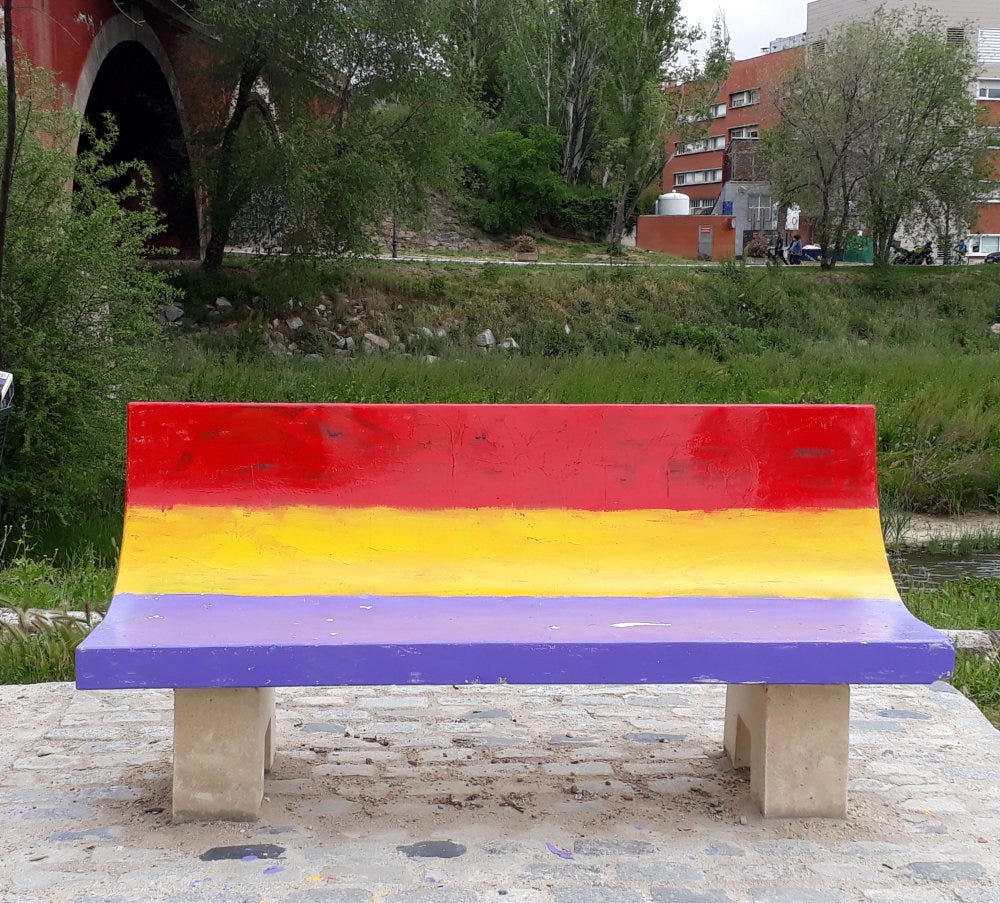Manzanares river from Puente del Rey after a very wet March. Ducks - or geese - in the middle, just to the right of the first tree.
April showers bring May flowers – and yes we have had rain, but nothing like March: this year we had a very, very, VERY wet March. It rained at least a little almost every single day, until the very end of the month. An interesting map was floating around Facebook showing that Spain had 300% more precipitation than usual, while the rest of Europe was extremely dry. Most of that weather came from the southwest, and likely was because the Azores high pressure system was a lot farther north than usual, blocking the low systems from northern Europe.
Here in Spain it is best to not complain when it rains, except extreme flood situations like in Valencia, which are not unknown. This was mostly soft, soaking rain with some bouts of harder rain. Most of the reservoirs in the south half of the country are now full, YAY! And Madrid’s Manzanares river really showed its personality as a mountain stream with an extremely varied water flow. I had never seen it like that full, and while it has gone way down (see photo) it is still a lot higher than usual, and probably will be like that until summer, because there’s also a lot of snow in the Guadarrama mountains north of the city.
But now we are all ready for some sun, thank you very much. This was not supposed to be a weather report, but news is news, right?
So yesterday was technically Spanish Republic Day, though not celebrated as a holiday. (ummm. I mostly wrote this yesterday, but made the mistake of looking at Facebook and got distracted).
The Second Spanish Republic was declared on April 14, 1931. Best to not even mention the first Republic, it was a messy one-year fiasco in the 1870’s.
The second Republic was declared after a soft-dictatorship, which happened because the Spanish king Alfonso XIII was not doing a great job and the political factions on left and right were getting rambunctious wanting more power within the limited framework of that monarchy – we’re talking socialists, anarchists, far right factions tempted by Italian fascism and a lot more. Basically Alfonso gave his ok to the dictatorship, which held things together for about seven years, then no longer worked. Alfonso called for municipal elections which should have been a vote of confidence for him, but went the other way, so he said, you don’t want me any more? I’m out of here, renounced the throne (though did not abdicate) and left. And the Second Republic was declared.
Spain was a mess in just about every possible way – economy was a mess, lots of political “connection-ism” and corruption, very high illiteracy, huge agrarian issues – so the Republic had its work cut out for itself. All of that while dealing with resistance from the army, the church, the far right and the quasi fascist or fascist party the Falange.
Within a a very complicated domestic situation and equally complicated international situation – Mussolini and Hitler on the rise – the Second Republic actually did some very good things. They built a lot of schools, created a cultural program where young people travelled the country as a roving theater group to take classic Spanish theater to rural areas, new rights for women, major agrarian reform, improved conditions for industrial workers. A lot of very necessary change but too fast for the Church, the Army, the far right, and the rising almost-fascist party the Falange.
Very long and complicated story short: the Republic lasted until summer of 1936, when a military uprising led by Francisco Franco and other army generals started a savage civil war (1936 – 1939); Franco et al won and Spain had a totalitarian government under Franco until his death in 1975.
There was some desire to return to a Republic after his death, but not enough desire to make that very complicated thing happen, so Spain transitioned immediately to a parliamentary monarchy and created a new Constitution in 1978. The current king is great-grandson of the king that abdicated (Alfonso XIII, king until 1931 – Juan, never ruled – Juan Carlos, king 1975 – abdication 2014 – Felipe VI). His daughter Princess Leonor will be queen.
That part of Spanish history still raises a lot of strong emotion – I was going to talk about that here, but it is too complicated for a newsletter. As an indication, see photo below of what I called the Bench of Discord, painted in the colors of the Second Republic flag (red-yellow-purple, the Spanish flag is red-yellow-red). This flag-bench was defaced by Franco-ish people with rude fascist and Franco-ish slogans, repainted, more slogans, repainted, etc etc. That went on for months. Yes, technically graffiti which is a bad thing but perhaps has its place as an outlet for political feeling, better that than physical street brawling, which was a major issue during the Second Republic.
There is still some talk about returning to a Republic so the Head of State would be elected instead of hereditary, but that talk has quieted down in recent years because Spain’s monarchy has more good things than bad things, in the opinion of most (though not all) Spaniards.
Even though the monarchy is fully consolidated, nevertheless, as you travel around Spain, especially mid-April, you might see Republic flags hanging from balconies, though never from official buildings.




